Abstract
Six pairs of pigs were fed a basal diet, a high-fiber diet, and a diet high in corn oil in different sequences to minimize the carry-over effect of diet. After 2 months on each diet, a fecal specimen from each pig was cultured on nonselective medium in roll tubes. Fifty colonies were randomly selected from each fecal sample, and isolates were characterized to identify a representative cross section of the fecal flora. The bacterial composition of the fecal flora differed between basal and high-fiber diets (P = 0.002) and between high-fiber and high-oil diets (P = 0.015). However, the floras were not significantly different between the basal and the high-oil diets (P = 0.135), nor were the floras of the 12 individual pigs (each on all three diets) statistically different (P = 0.103). Only 14 of the 160 observed taxa have been detected in the human fecal flora, and only 159 of 1,871 total isolates (8.5%) were members of described species. The most common isolate was a Streptococcus species similar to that reported by Robinson et al. (I. M. Robinson, S. C. Whipp, J. A. Bucklin, and M. J. Allison, Appl. Environ. Microbiol. 48:964-969, 1984), which was found in 34 of 36 samples and which represented 27.5% of all isolates. Lactobacillus, Fusobacterium, Eubacterium, Bacteroides, and Peptostreptococcus species were the next most common bacteria. Escherichia coli represented 1.7% of all fecal isolates, which is somewhat higher than the 0.1 to 0.6% observed in human feces cultured similarly with prereduced anaerobically sterilized media.(ABSTRACT TRUNCATED AT 250 WORDS)
Full text
PDF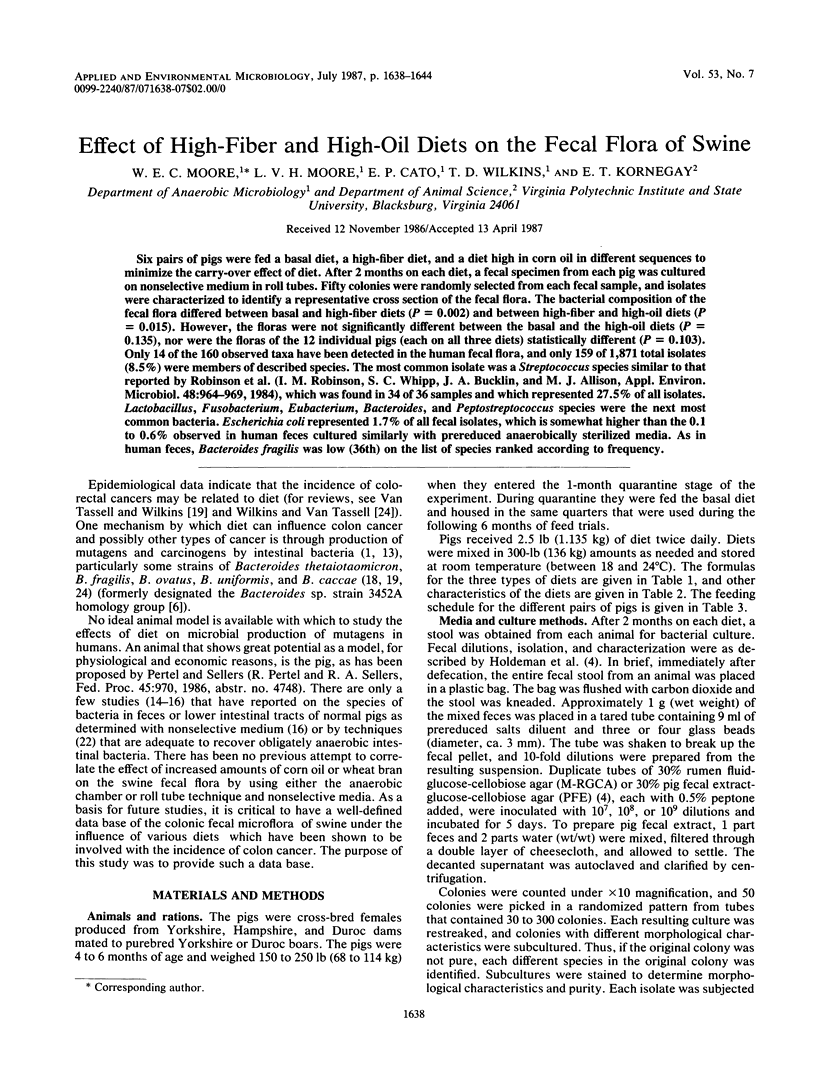

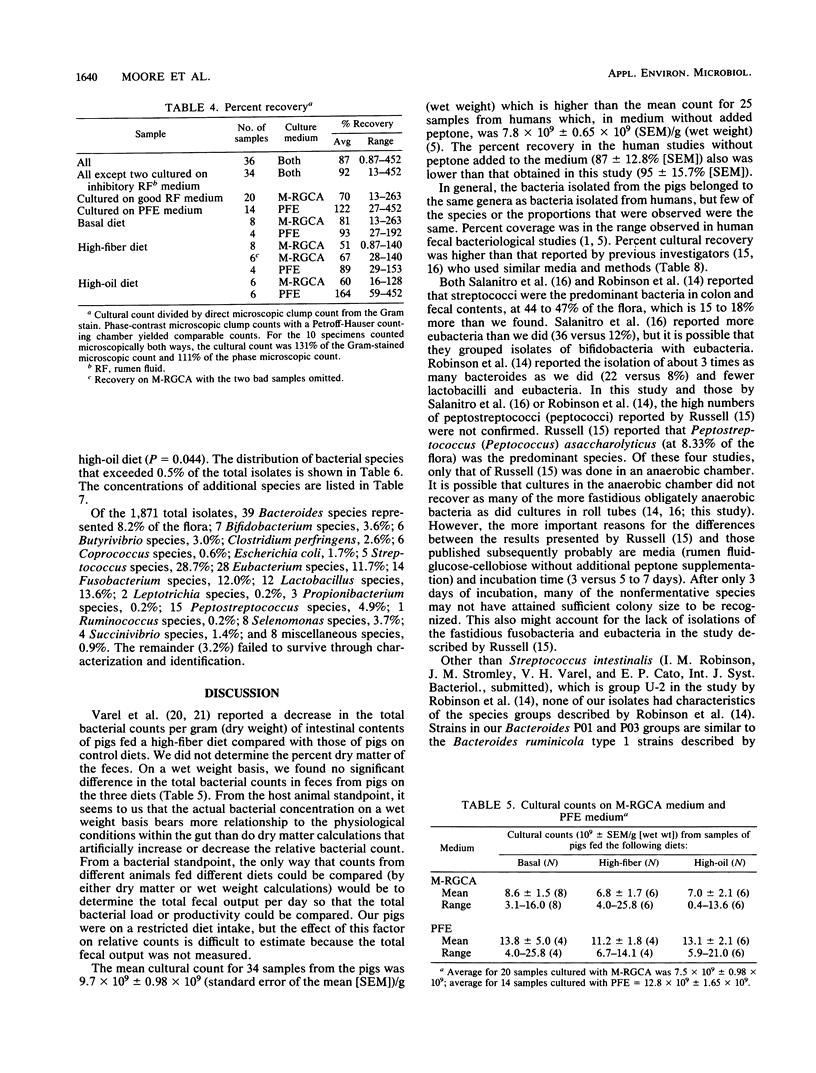
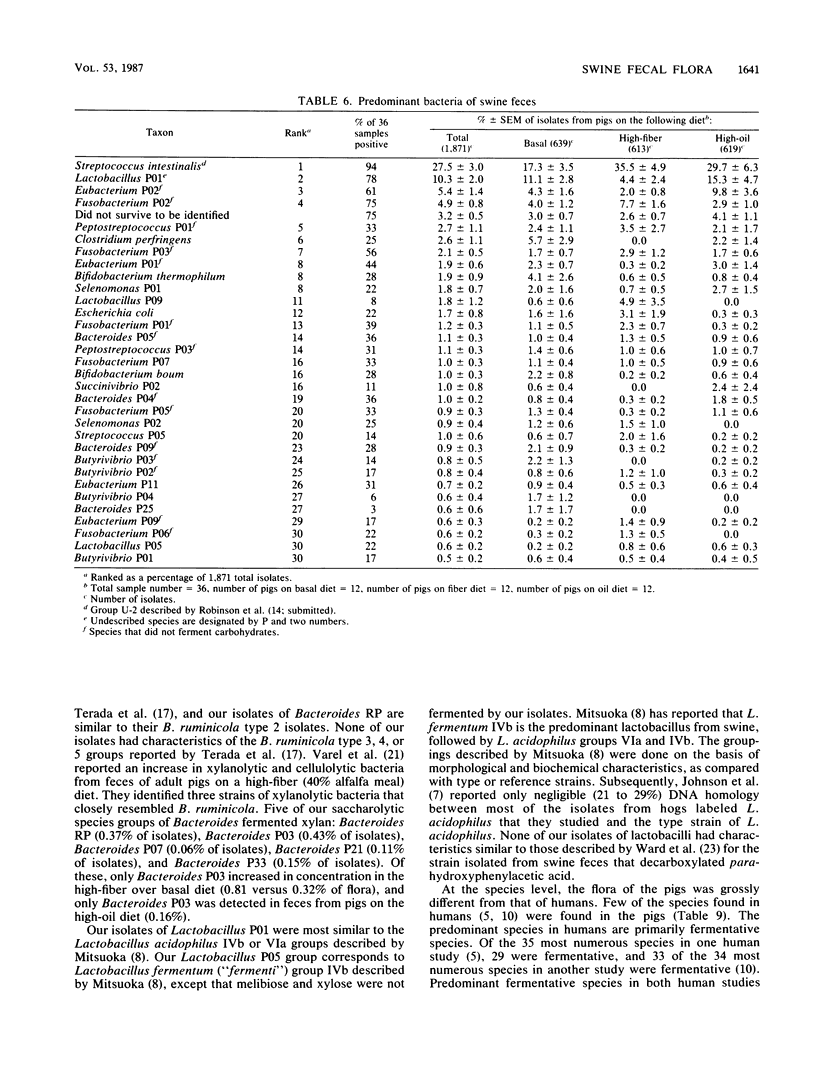
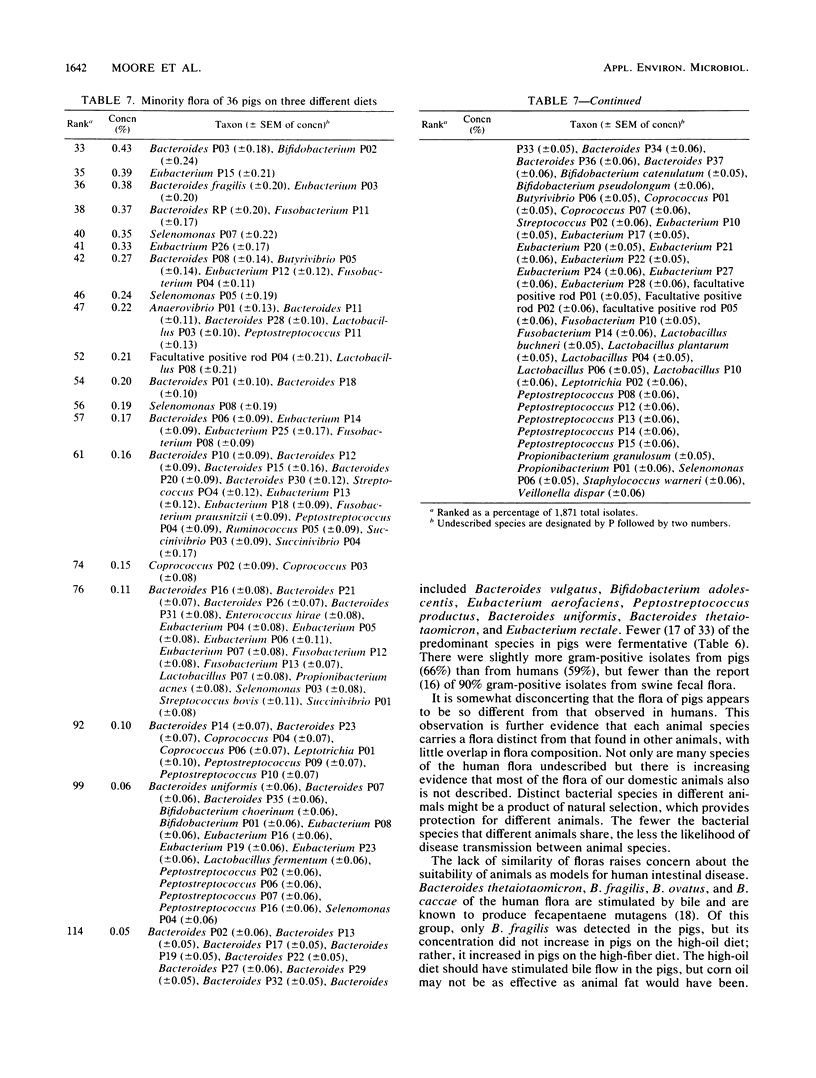

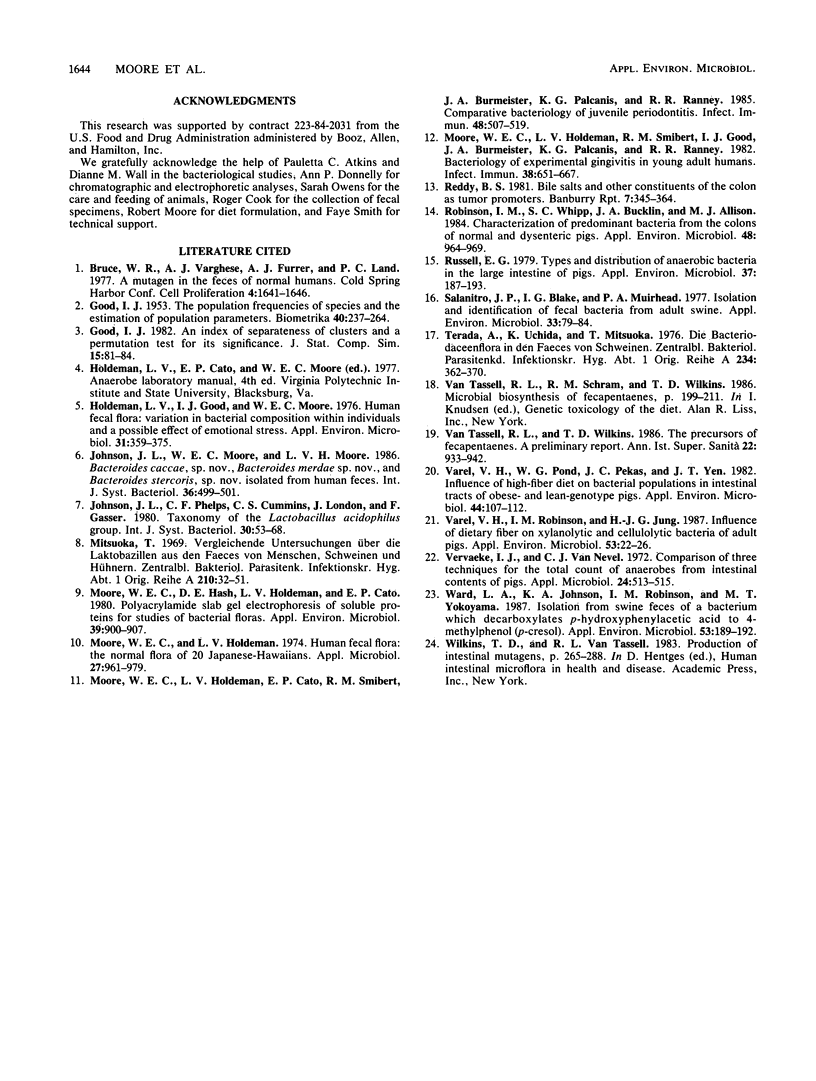
Selected References
These references are in PubMed. This may not be the complete list of references from this article.
- Holdeman L. V., Good I. J., Moore W. E. Human fecal flora: variation in bacterial composition within individuals and a possible effect of emotional stress. Appl Environ Microbiol. 1976 Mar;31(3):359–375. doi: 10.1128/aem.31.3.359-375.1976. [DOI] [PMC free article] [PubMed] [Google Scholar]
- Mitsuoka T. Vergleichende Untersuchungen über die Laktobazillen aus den Faeces von Menschen, Schweinen und Hühnern. Zentralbl Bakteriol Orig. 1969 May;210(1):32–51. [PubMed] [Google Scholar]
- Moore W. E., Hash D. E., Holdeman L. V., Cato E. P. Polyacrylamide slab gel electrophoresis of soluble proteins for studies of bacterial floras. Appl Environ Microbiol. 1980 Apr;39(4):900–907. doi: 10.1128/aem.39.4.900-907.1980. [DOI] [PMC free article] [PubMed] [Google Scholar]
- Moore W. E., Holdeman L. V., Cato E. P., Smibert R. M., Burmeister J. A., Palcanis K. G., Ranney R. R. Comparative bacteriology of juvenile periodontitis. Infect Immun. 1985 May;48(2):507–519. doi: 10.1128/iai.48.2.507-519.1985. [DOI] [PMC free article] [PubMed] [Google Scholar]
- Moore W. E., Holdeman L. V. Human fecal flora: the normal flora of 20 Japanese-Hawaiians. Appl Microbiol. 1974 May;27(5):961–979. doi: 10.1128/am.27.5.961-979.1974. [DOI] [PMC free article] [PubMed] [Google Scholar]
- Moore W. E., Holdeman L. V., Smibert R. M., Good I. J., Burmeister J. A., Palcanis K. G., Ranney R. R. Bacteriology of experimental gingivitis in young adult humans. Infect Immun. 1982 Nov;38(2):651–667. doi: 10.1128/iai.38.2.651-667.1982. [DOI] [PMC free article] [PubMed] [Google Scholar]
- Robinson I. M., Whipp S. C., Bucklin J. A., Allison M. J. Characterization of predominant bacteria from the colons of normal and dysenteric pigs. Appl Environ Microbiol. 1984 Nov;48(5):964–969. doi: 10.1128/aem.48.5.964-969.1984. [DOI] [PMC free article] [PubMed] [Google Scholar]
- Russell E. G. Types and distribution of anaerobic bacteria in the large intestine of pigs. Appl Environ Microbiol. 1979 Feb;37(2):187–193. doi: 10.1128/aem.37.2.187-193.1979. [DOI] [PMC free article] [PubMed] [Google Scholar]
- Salanitro J. P., Blake I. G., Muirhead P. A. Isolation and identification of fecal bacteria from adult swine. Appl Environ Microbiol. 1977 Jan;33(1):79–84. doi: 10.1128/aem.33.1.79-84.1977. [DOI] [PMC free article] [PubMed] [Google Scholar]
- Terada A., Uchida K., Mitsuoka T. Die Bacteroidaceenflora in den Faeces von Schweinen. Zentralbl Bakteriol Orig A. 1976 Apr;234(3):362–370. [PubMed] [Google Scholar]
- Van Tassell R. L., Schram R. M., Wilkins T. D. Microbial biosynthesis of fecapentaenes. Prog Clin Biol Res. 1986;206:199–211. [PubMed] [Google Scholar]
- Van Tassell R. L., Wilkins T. D. The precursors of fecapentaenes. A preliminary report. Ann Ist Super Sanita. 1986;22(3):933–941. [PubMed] [Google Scholar]
- Varel V. H., Pond W. G., Pekas J. C., Yen J. T. Influence of high-fiber diet on bacterial populations in gastrointestinal tracts of obese- and lean-genotype pigs. Appl Environ Microbiol. 1982 Jul;44(1):107–112. doi: 10.1128/aem.44.1.107-112.1982. [DOI] [PMC free article] [PubMed] [Google Scholar]
- Varel V. H., Robinson I. M., Jung H. J. Influence of dietary fiber on xylanolytic and cellulolytic bacteria of adult pigs. Appl Environ Microbiol. 1987 Jan;53(1):22–26. doi: 10.1128/aem.53.1.22-26.1987. [DOI] [PMC free article] [PubMed] [Google Scholar]
- Vervaeke I. J., Van Nevel C. J. Comparison of three techniques for the total count of anaerobes from intestinal contents of pigs. Appl Microbiol. 1972 Sep;24(3):513–515. doi: 10.1128/am.24.3.513-515.1972. [DOI] [PMC free article] [PubMed] [Google Scholar]
- Ward L. A., Johnson K. A., Robinson I. M., Yokoyama M. T. Isolation from swine feces of a bacterium which decarboxylates p-hydroxyphenylacetic acid to 4-methylphenol (p-cresol). Appl Environ Microbiol. 1987 Jan;53(1):189–192. doi: 10.1128/aem.53.1.189-192.1987. [DOI] [PMC free article] [PubMed] [Google Scholar]


